Reflecting on preserving Filipino culture, I wonder: what can I do to protect our heritage? The colonial legacy has a big impact on our culture. The Philippines is rich in traditions and has over 175 ethnolinguistic groups. Preserving this heritage is key for national unity and identity.
Our culture is a big part of who we are. It’s important to keep values like malasakit, bayanihan, and pangaddatan alive. These values help us feel connected and included in our communities. It’s also important to balance making money from tourism with keeping our culture safe. This way, we can help indigenous communities keep their traditions and natural resources.
Key Takeaways
- PRESERVING Filipino culture is essential for national unity and identity.
- Our culture is a vital part of who we are, and it is essential to nurture values like malasakit, bayanihan, and pangaddatan.
- Efforts to create a cultural database are constrained by a lack of cultural experts and funding.
- Heritage structures in the Philippines are vulnerable to climate change and human-induced disasters.
- PRESERVING the cultural heritage of the Philippines through its indigenous peoples offers benefits such as reinforcing the sense of identity, creating economic opportunities, serving as guardians of natural environments, and fostering cross-cultural understanding.
- Initiatives in the Philippines aim to balance economic development with cultural preservation to support indigenous communities.
Understanding Filipino Culture and Its Importance
Filipino culture is rich and varied, shaped by history, geography, and global interactions. The Philippines, with over 7,000 islands, has a unique mix of Eastern and Western traditions. This mix has created a distinct identity that is truly Filipino.
Respecting elders is a big part of Filipino culture. The “mano” gesture, where you place your forehead on an elder’s hand, shows respect. Saying “po” and “opo” in conversations also shows politeness and respect. These customs help us understand the Filipino identity and its values.
Some key parts of Filipino culture include:
- Vibrant festivals like Sinulog and Ati-Atihan, which celebrate the country’s rich heritage
- “Kamayan,” or eating with hands, is a traditional Filipino way of eating
- “Tabi-Tabi Po,” a phrase used to ask permission before entering areas believed to have spirits
It’s important to understand Filipino culture to appreciate the nation’s rich heritage and identity. By keeping these traditions alive, Filipinos can celebrate their unique culture and share it with future generations.
| Cultural Practice | Description |
|---|---|
| Mano | A gesture of respect, where individuals place their forehead on the hand of an elder |
| Kamayan | A traditional Filipino culinary tradition, where food is eaten with hands |
| Tabi-Tabi Po | A phrase used to seek permission before entering areas believed to be inhabited by spirits |
The Significance of Heritage Sites
Heritage sites are key in keeping Filipino culture alive. The Philippines boasts many sites, like the Ifugao Rice Terraces and Tubbataha Reef National Park. These places show off the country’s deep cultural and natural heritage.
It’s important for communities to help take care of these sites. They can join in conservation work, like cleaning and fixing things. They can also teach others about culture and attract tourists. This helps keep the sites safe and boosts the local economy, creating jobs.
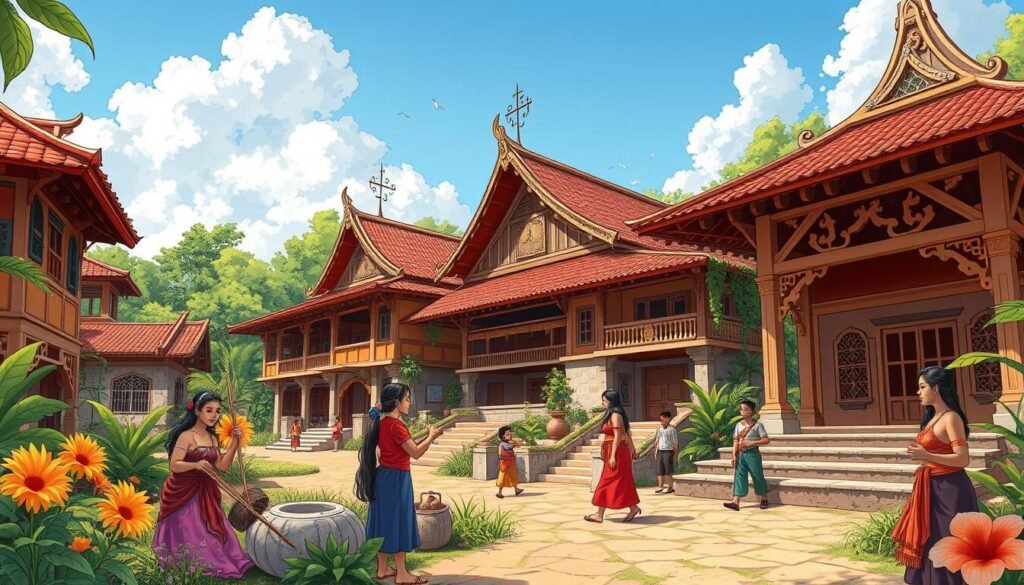
These sites are not just culturally and historically significant. They are also beautiful and full of life.
By focusing on heritage conservation and getting communities involved, we can protect the Philippines’ cultural and natural treasures for the future.
Filipino Traditions and Customs
Filipino traditions and customs are key to the nation’s identity. The Philippines is famous for its lively festivals and celebrations. These traditions help share cultural values and keep cultural awareness alive.
Keeping the country’s cultural heritage alive is vital for its future. The Indigenous Peoples’ Rights Act of 1997 protects indigenous communities’ cultural rights. This includes their traditions and customs.
Festivities and Celebrations Unique to the Philippines
The Philippines has unique festivals like the Sinulog and MassKara. These events highlight the country’s cultural richness. They are a big part of Filipino tradition.
Traditional Filipino Arts and Crafts
Traditional Filipino arts and crafts, like weaving and woodcarving, are important. These traditions have been passed down through generations. They help shape the nation’s identity.
Looking ahead, preserving cultural heritage is critical for the Philippines. By keeping traditions and customs alive, the country can safeguard its rich cultural diversity. This ensures it remains vibrant for future generations.
| Festival | Location | Description |
|---|---|---|
| Sinulog Festival | Cebu | A celebration of the Santo Niño |
| MassKara Festival | Bacolod | A festival of smiles and masks |
The Role of Education in Cultural Preservation
Education is key in saving our cultural heritage. It teaches people to value and understand their culture. By learning about Filipino culture in school, students get to know their roots better.
The Philippine Development Plan 2017-2022 stresses education’s role in keeping culture alive. It talks about the need to make students appreciate their culture. This can be done in many ways, like:
- Incorporating Filipino culture in school curricula
- Organizing cultural festivals and events
- Encouraging student participation in cultural activities
Education helps keep our cultural heritage alive by making people aware and appreciative of it. This awareness helps preserve our traditions and customs for the next generations.
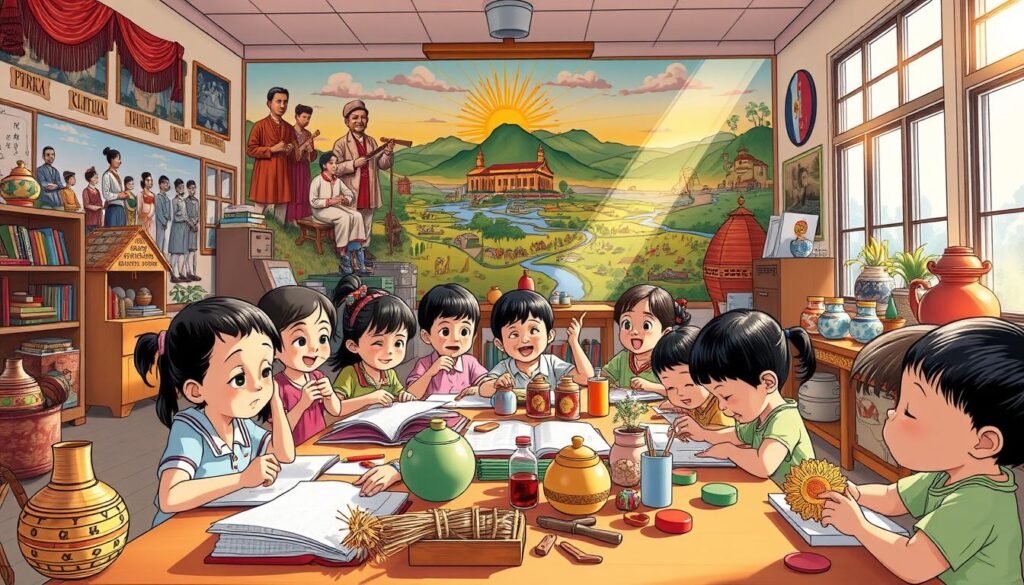
In short, education is vital in saving our cultural heritage. It promotes awareness, appreciation, and conservation. This way, it helps keep our cultural identity strong.
| Aspect of Education | Role in Cultural Preservation |
|---|---|
| Incorporating Filipino culture in school curricula | Promotes cultural awareness and appreciation |
| Organizing cultural festivals and events | Encourages student participation in cultural activities |
| Encouraging student participation in cultural activities | Helps to conserve cultural heritage and promote cultural identity |
Media’s Influence on Cultural Representation
The media shapes how we see heritage and tradition. It can help us appreciate different cultures. The Philippine Development Plan 2017-2022 says media is key in promoting positive cultural values. Sinaunangpanahon.com notes that media can deeply affect how we view different groups.
Media can change how we see groups, making it vital to show them accurately. Showing diverse groups in a positive light can boost self-esteem. It can also inspire young people.
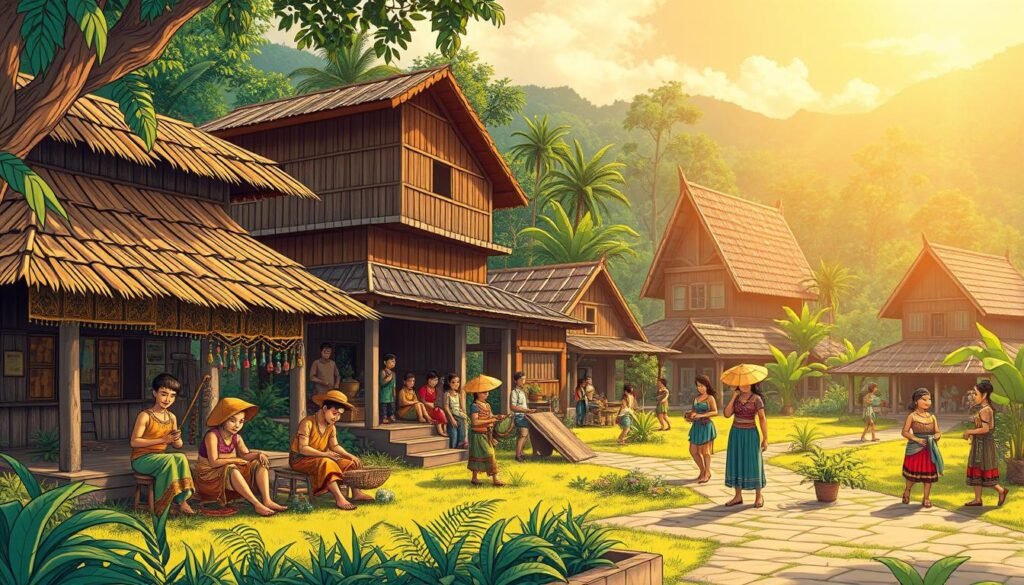
The Role of Television and Film in Cultural Narratives
TV and movies can help us appreciate different cultures. They can show diverse identities in a real way. This can challenge stereotypes and open our minds to new views.
It’s up to the media industry to show diverse cultures. Working together is key to making sure everyone is represented fairly.
Social Media: A Double-Edged Sword
Social media can be both good and bad for cultural heritage and tradition. It can help share cultural awareness but also spread misinformation. To show cultures accurately, media needs to hire and train diverse talent.
- Media representation plays a key role in shaping public opinion and societal norms.
- Showing diverse identities in media can challenge stereotypes and open our minds.
- Working together is essential to ensure everyone is represented fairly in media.
Media has often spread stereotypes and biases. We need to challenge these harmful stories to make media more inclusive.
| Media Platform | Cultural Representation |
|---|---|
| Television | Promotes cultural appreciation and awareness |
| Film | Authentic depiction of diverse identities |
| Social Media | Double-edged sword, can promote or undermine cultural heritage |
Community Initiatives for Cultural Preservation
Community efforts are key in keeping our culture alive. Local groups like cultural centers and museums help share and learn about our heritage. In the Philippines, the “Save Our Heritage” campaign has really made a difference.
Grassroots movements, led by women fighting for indigenous rights, are very important. Angela Jacob Bermudo and Boi Maria Todi are great examples. They work hard to keep our indigenous knowledge and culture alive.
These efforts help us build a sustainable future. By getting local people, including young ones, involved in preserving our heritage, we ensure it lasts. Here are some ways to engage youth:
- Interactive workshops and educational programs
- Field trips to historical sites
- Oral history interviews with elderly residents
- Creating art inspired by our cultural heritage
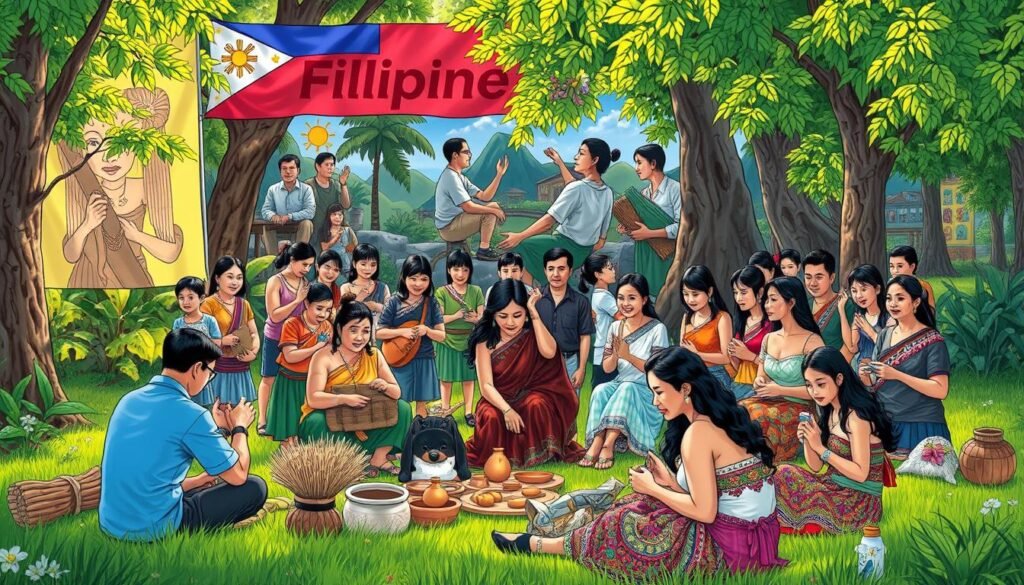
Supporting these community and grassroots efforts helps us value and preserve our cultural heritage. This benefits our community and helps keep our cultural identity rich and diverse for the future.
| Initiative | Objective | Impact |
|---|---|---|
| Save Our Heritage | Promote cultural awareness and preservation | Engaged community members in preserving cultural heritage |
| Amanu | Promote indigenous storytelling and knowledge | Preserved and promoted indigenous culture and heritage |
The Importance of Indigenous Cultures
Indigenous cultures are key in shaping the nation’s identity and keeping its heritage alive. The Philippines has over 175 ethnolinguistic groups, each with its own way of life. This diversity is a big part of the Filipino cultural scene.
But, indigenous communities face big challenges. They deal with land loss, forced moves, and limited access to education and healthcare.
The Indigenous Peoples’ Rights Act of 1997 protects their rights. It helps them keep their cultural heritage alive. This includes their traditions, languages, and customs, which are vital to their identity.
Efforts are underway to help indigenous communities. This includes programs to revive languages and education initiatives.
Some important facts about preserving indigenous cultures are:
- Almost 90% of all languages could disappear in the next 100 years.
- Traditional foods of Indigenous Peoples are linked to their health, well-being, and cultural ties.
- Many indigenous cultures are at risk of disappearing due to land loss and lack of access to resources.
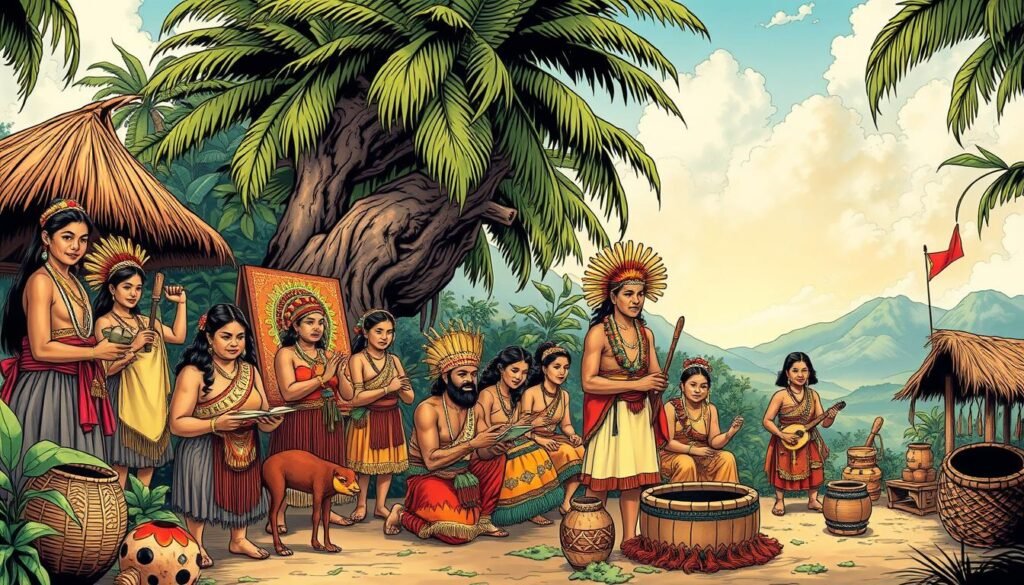
It’s vital to support indigenous communities in their efforts to keep their cultural heritage and identity alive. We can do this through education, language programs, and recognizing their rights to their ancestral lands.
Balancing Modernization and Tradition
The Philippines is moving forward with modernization. Yet, it’s key to think about how this affects our cultural ways. The Philippine Development Plan 2017-2022 highlights the need to keep cultural heritage alive while we modernize. This balance is vital for keeping our tradition and conservation of cultural practices strong.
In many places, modern ways have hurt traditional values and customs. But, we can mix tradition with today’s life. For example, in Japan, the tea ceremony tradition lives on. People do ancient rituals and use traditional tools, even with modern comforts around.
Strategies for Integrating Tradition into Modern Life
Here are some ways to blend tradition with modern life:
- Promoting cultural awareness and appreciation
- Supporting cultural events and festivals
- Incorporating traditional practices into daily life
By using these strategies, the Philippines can keep its cultural heritage alive while enjoying modern advancements. It’s important to find a balance. This way, we can preserve our cultural roots for the next generations.
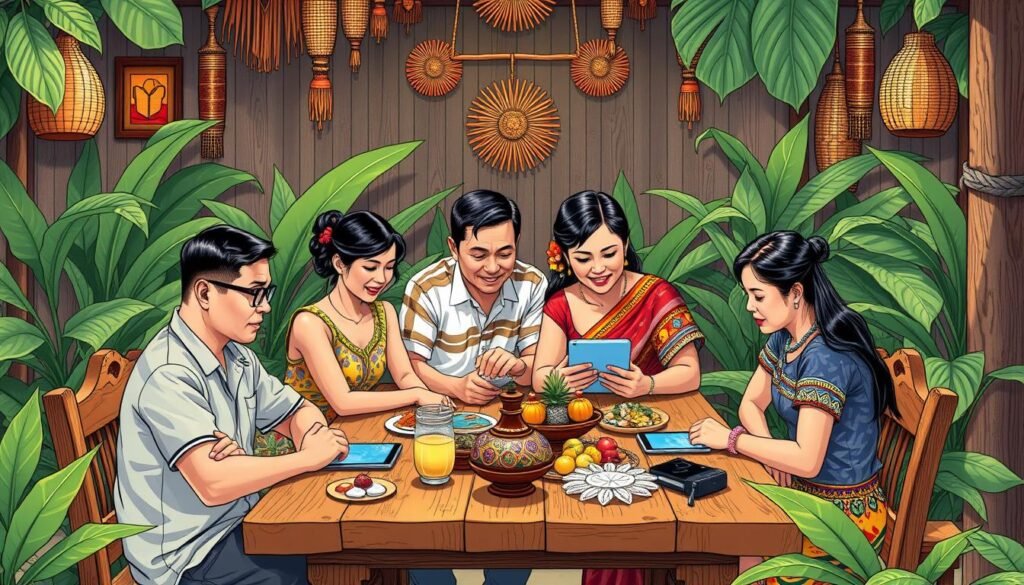
Role of Technology in Cultural Preservation
Technology is key in keeping our cultural heritage alive for future generations. Digital archives and online platforms help spread cultural awareness. The Philippine Development Plan 2017-2022 stresses the importance of technology in preserving our heritage.
A study by amt-lab.org shows how vital technology is. It’s used in many ways, like:
- Virtual Reality (VR) for interactive digital models of buildings and monuments
- Laser scanners for accurate three-dimensional digital models of heritage objects
- Drones for aerial images of monuments and archaeological sites
These tools help document, share, and protect traditions globally. They help secure a better future for our cultural heritage.
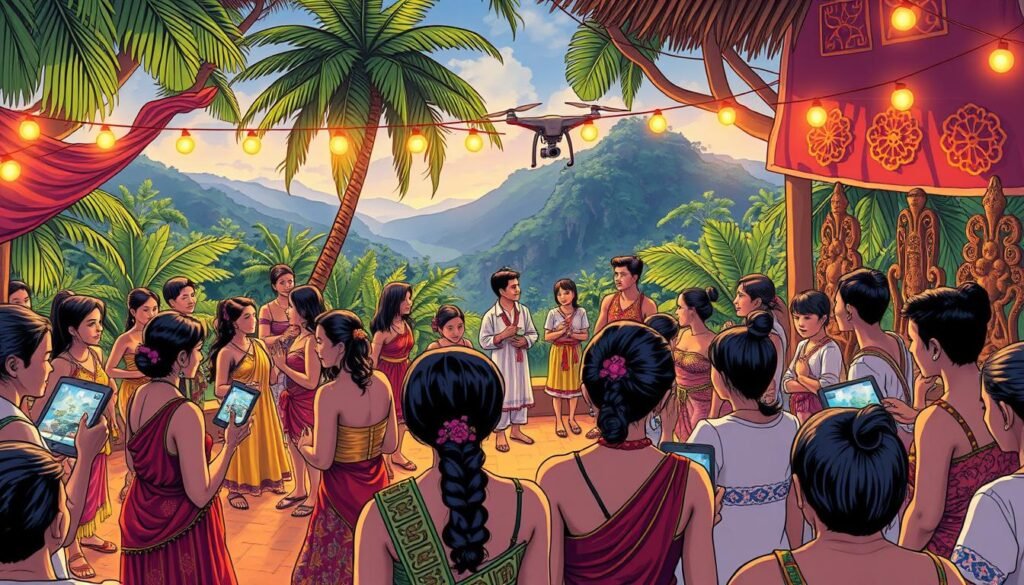
By using technology, we can protect our cultural heritage for future generations. This will lead to a brighter future for our cultural landscape.
| Technology | Application |
|---|---|
| Virtual Reality (VR) | Creating interactive digital models |
| Laser Scanners | Developing highly accurate three-dimensional digital models |
| Drones | Capturing aerial images of monuments and archaeological sites |
Supporting Local Art and Artists
Supporting local art and artists is key to keeping our cultural heritage alive. It helps share our cultural values and raise awareness. The Philippine Development Plan 2017-2022 stresses the importance of art and culture in preserving our tradition and identity.
Galleries and art exhibitions in the Philippines offer a stage for local artists. They showcase various art forms like paintings, sculptures, and installations. Supporting local art boosts cultural appreciation and awareness in communities. Some benefits include:
- Fostering social cohesion and community spirit through local art events
- Encouraging young and emerging artists to pursue their creative passions
- Adding character and personality to living or working spaces with original art pieces
The arts and culture sector in the United States brings in $166.3 billion annually. Local artists often spend their earnings in their communities. This supports local businesses and boosts our economy, promoting our identity.
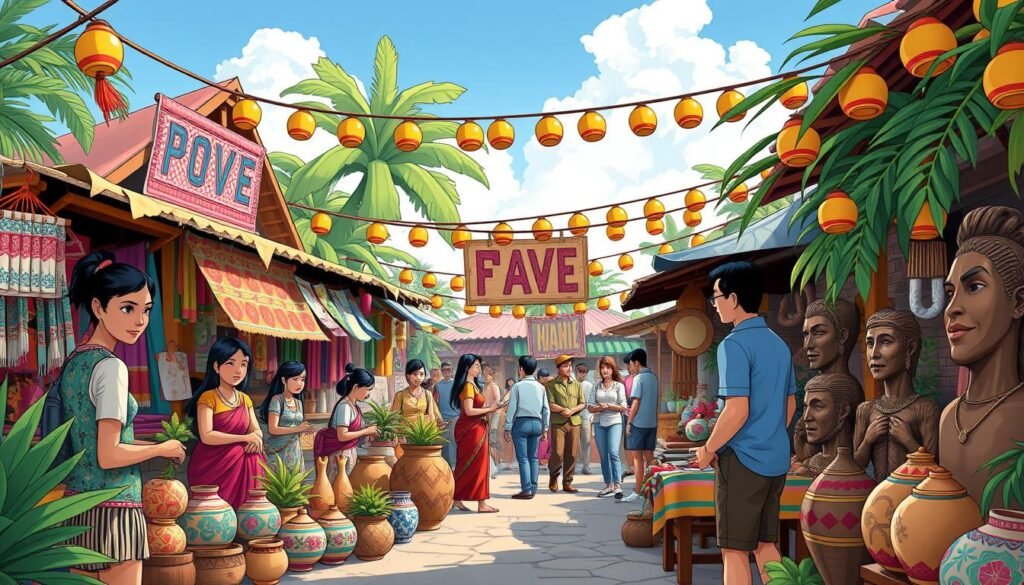
In summary, backing local art and artists is vital for our cultural tradition and identity. It helps build community, supports new artists, and grows our local economy.
The Influence of Filipino Cuisine
Filipino cuisine is key in showing off the country’s heritage and conservation work. It mixes indigenous, Chinese, Spanish, and American tastes. This mix makes Filipino food unique and full of flavor, showing off the country’s history and culture.
The Philippine Development Plan 2017-2022 sees cultural heritage in food as vital. Dishes like adobo and sinigang are tasty and carry cultural meaning. They help people appreciate and learn about their culture.
Some famous Filipino dishes that show off the country’s culinary heritage include:
- Lechon
- Pancit
- Lumpia
- Adobo
- Sisig
When people around the world try Filipino food, it helps them understand and value Filipino culture. It’s important to keep Filipino food traditions alive. This helps protect the country’s cultural heritage.
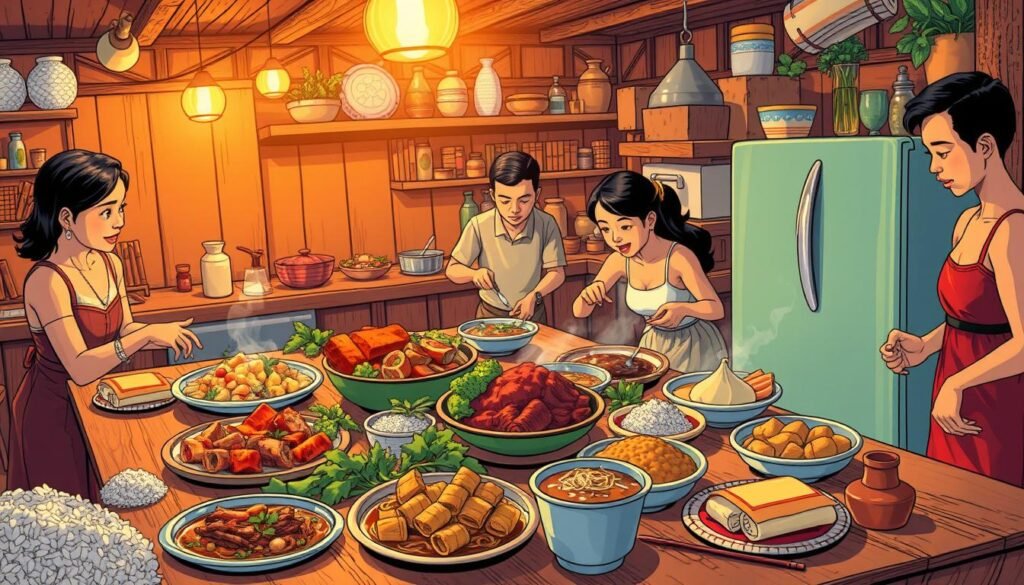
| Dish | Description |
|---|---|
| Adobo | A classic Filipino dish made with meat or seafood, vinegar, and soy sauce |
| Sinigang | A sour soup made with tamarind broth and various vegetables and proteins |
Family Dynamics in Cultural Transmission
Family dynamics are key in passing down cultural values and awareness. They help share cultural traditions from one generation to the next. The effects of family culture on beliefs, values, and behaviors are deep. Families are seen as the main way culture is passed on through daily life, rituals, and traditions.
The early years in a family shape all future learning and social interactions. Cultural values like language, religious practices, and food customs are learned at home. These help form identity. Families keep cultural heritage alive and support societal norms, playing a vital role in preserving culture.
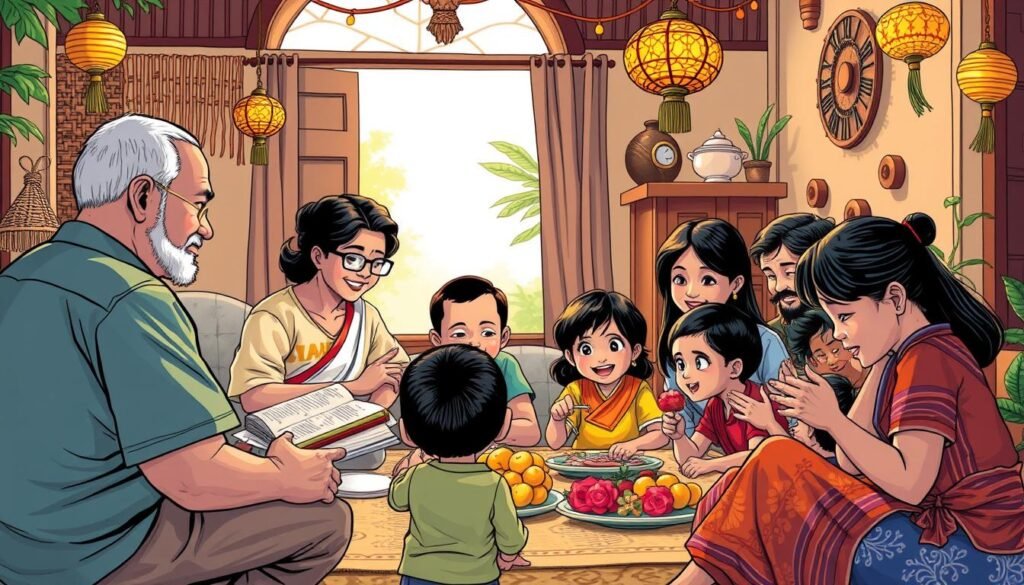
Important aspects of family dynamics in cultural transmission include:
- Passing down traditions through generations
- The role of family events in cultural retention
- Cultural transmission through language, religious practices, and social rituals
These points show how family shapes individual and collectiveidentity. They also ensure cultural heritage continues.
Government Policies and Cultural Preservation
The Philippine government has made laws to protect its cultural heritage. The National Cultural Heritage Act of 2009 is one such law. It aims to keep the nation’s cultural treasures safe and promote them.
The National Commission for Culture and the Arts (NCCA) is key in this effort. Working with local governments is also vital for success.
According to the National Cultural Heritage Act of 2009, there are different types of cultural sites. The law calls for a complete approach to save these sites. This means using all kinds of knowledge and technology.
It’s important to find a balance between old and new. This way, both today’s and tomorrow’s generations can enjoy these treasures.
The Philippine government is doing a great job in saving its heritage. It has set up the Philippine Registry of Cultural Property and the NCCA Portal Cultural Databank. These help in keeping cultural sites safe.
Also, some places are called “National cultural treasures” or “Important cultural property.” This shows how much they mean to the Philippines.
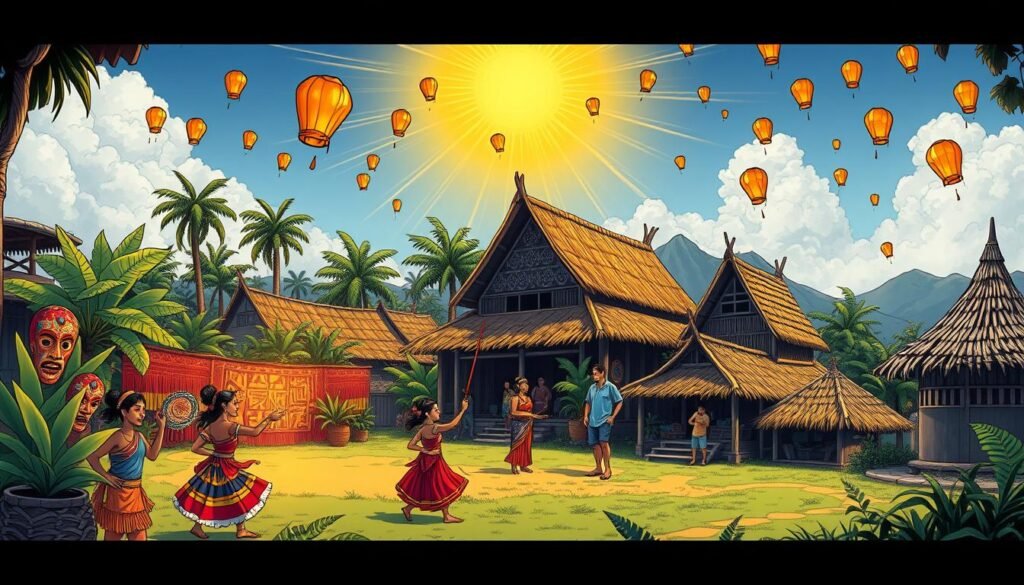
Government policies are very important for saving cultural heritage. The Philippines is on the right path. By focusing on conservation and heritage preservation, it can protect its rich culture for the future.
International Representation of Filipino Culture
The Philippines has a rich heritage that it can share with the world. By joining global cultural events, it can show off its unique traditions and values. This helps keep Filipino culture alive and growing, shaping the future of the nation.
According to the Philippine Development Plan 2017-2022, showing off cultural heritage abroad is key. This can be done in many ways, such as:
- Joining global cultural festivals and events
- Exchanging cultures with other countries
- Sharing Filipino arts, music, and literature worldwide
The Filipino diaspora is important in spreading Filipino culture. They act as cultural ambassadors, sharing their traditions with the world. This helps people understand and appreciate the Philippines’ rich heritage. It also helps build a brighter future for the country.
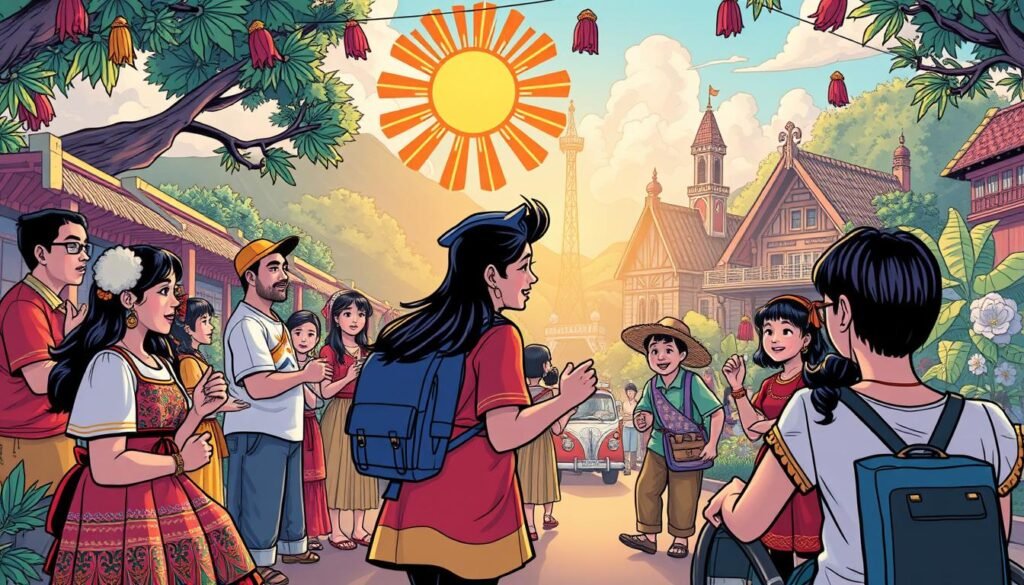
Role of the Filipino Diaspora in Cultural Promotion
The Filipino diaspora has a big role in promoting Filipino culture and heritage globally. By sharing their stories and traditions, they help the world understand the Philippines better. This strengthens national identity and secures a better future for the country.
My Commitment to Preserving Filipino Culture
Reflecting on my role in preserving Filipino culture, I see the value of tradition and conservation. It’s key for us to act personally to boost cultural awareness. The Indigenous Peoples’ Rights Act of 1997 backs this up, saying indigenous groups can protect their culture through personal efforts.
Supporting local art and artists is a big step in preserving cultural heritage. Joining in cultural events helps us understand and value Filipino culture more. For example, the Australia Day Festival in Melbourne celebrated national values and heritage, with people wearing traditional Filipino clothes.
Some stats show we need to do more for cultural preservation:
- Only 9 percent of Local Culture and Arts Councils (LCACs) in local government units are active.
- We have too few libraries, museums, and performance venues for preserving and promoting heritage.
Yet, there are positive signs, like more schools teaching arts and the rise of cultural products. To learn more about preserving Filipino culture, check out this resource on Baybayin, an ancient script.
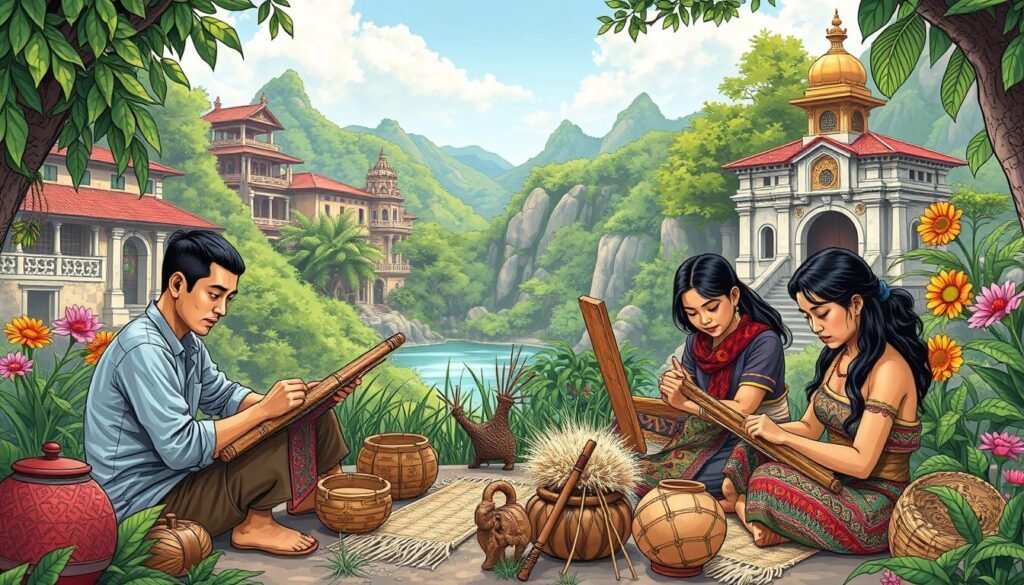
Personal Actions and Initiatives
I’m dedicated to personal actions that boost cultural awareness. This means supporting local artists, joining cultural events, and pushing for Filipino cultural heritage preservation.
Engaging the Community in Cultural Activities
Together, we can deepen our understanding and appreciation of Filipino culture. This can happen through community events, cultural festivals, and educational programs that highlight the importance of tradition and conservation.
Future Directions for Cultural Preservation
Looking ahead, keeping Filipino culture alive is key. New ways to save our heritage, like using technology and community efforts, are exciting. These methods help protect our rich culture for the next generations.
We dream of a future where culture is a big part of our lives. We want to make sure our traditions and stories are kept alive. This means improving education, working together, and listening to indigenous voices.
By doing these things, we aim to preserve and celebrate our heritage. This will make Filipinos everywhere feel proud and connected to their roots.
FAQ
What is the importance of preserving Filipino culture and traditions?
The Philippines has a rich mix of traditions and cultures. With over 175 ethnolinguistic groups, each has its own way of life. Keeping this heritage alive is key for the indigenous people and the nation’s identity.
How can understanding Filipino culture help appreciate the nation’s rich heritage?
Filipino culture includes the people’s way of life, beliefs, art, and values. Knowing these elements helps us appreciate the country’s unique cultural landscape. This landscape has been shaped by Spanish and American influences.
What is the significance of heritage sites in preserving Filipino culture?
Sites like the Ifugao Rice Terraces and Tubbataha Reef National Park show the country’s rich heritage. Keeping these sites alive involves the community. It helps in preserving these sites and promoting cultural awareness.
How do Filipino traditions and customs contribute to the country’s cultural heritage?
The Philippines is known for its vibrant festivals and traditional arts. These traditions help pass down cultural values. They promote cultural awareness from one generation to the next.
What is the role of education in preserving and promoting Filipino culture?
Education plays a big role in keeping Filipino culture alive. By teaching culture in schools and hosting cultural events, we ensure its preservation. This helps students and the community appreciate our heritage.
How do media and technology influence cultural representation and preservation?
Media can both help and harm cultural heritage. It can share cultural values but also spread misinformation. Technology, on the other hand, offers new ways to preserve and teach culture.
What is the significance of community initiatives in cultural preservation?
Local groups and cultural centers are vital in promoting Filipino culture. They provide platforms for cultural expression. Community involvement helps spread cultural awareness and appreciation.
How can indigenous cultures be better represented and supported?
The Philippines is home to over 175 ethnolinguistic groups. Indigenous communities face challenges like land loss and limited access to education and healthcare. Supporting these communities is key to preserving their heritage.
How can modernization and tradition be balanced?
Modernization can threaten traditional values, but it’s possible to blend heritage with modern life. Promoting cultural awareness and supporting cultural events can help. Incorporating traditions into daily life is also important.
What is the role of local art and artists in promoting cultural heritage?
Local art and artists are vital in sharing cultural values. Galleries and exhibitions in the Philippines showcase local talent. This has a big impact on cultural identity and appreciation.
How does Filipino cuisine contribute to the preservation of cultural heritage?
Traditional dishes like adobo and sinigang are cultural symbols. They promote cultural appreciation and awareness. The global recognition of Filipino cuisine also helps spread cultural awareness.
What is the role of family dynamics in the transmission of cultural heritage?
Family plays a key role in passing down cultural values. By sharing traditions, families help preserve cultural heritage. Family events also help retain and promote cultural values.
How do government policies and programs support cultural preservation?
Government policies and programs, like those by the National Commission for Culture and the Arts, help preserve culture. Working with local governments ensures these efforts are effective.
What is the significance of international representation of Filipino culture?
Being part of global events and the Filipino diaspora helps represent our culture. It promotes cultural awareness among international audiences.
How can individuals contribute to the preservation of Filipino culture?
Individuals can help preserve Filipino culture by supporting local art and artists. Engaging in cultural activities and promoting cultural awareness are also important.
What are the future directions for cultural preservation in the Philippines?
New trends like digital preservation and community-based conservation are emerging. These, along with a vision for a culturally rich future, will help preserve Filipino culture for generations to come.
Source Links
- PDF – https://pdp.neda.gov.ph/wp-content/uploads/2017/01/Chapter-7-Prepublication.pdf
- Preserving the Cultural Heritage of the Philippines through the Indigenous Peoples – Mustaqim – https://mustaqim.com.ph/preserving-the-cultural-heritage-of-the-philippines-through-the-indigenous-peoples/
- Cultural Heritage Preservation – https://ph.usembassy.gov/cultural-heritage-preservation/
- Discover Filipino Culture: Festivals, Traditions, and Values – https://makeyourasia.com/philippines/filipino-culture.html
- Culture of the Philippines – https://en.wikipedia.org/wiki/Culture_of_the_Philippines
- The Concept and History of Cultural Heritage – https://culturalheritagestudies.ceu.edu/concept-and-history-cultural-heritage
- Longdom Publishing SL | Open Access Journals – https://www.longdom.org/open-access/cultural-heritage-its-significance-and-preserving-105460.html
- Cultural Significance for World Heritage Sites: Understanding the Concept of Outstanding Universal Value – https://intramuros.gov.ph/2020/09/26/cultural-significance-for-world-heritage-sites-understanding-the-concept-of-outstanding-universal-value/
- Philippines – Culture, Diversity, Traditions | Britannica – https://www.britannica.com/place/Philippines/Cultural-life
- Warning: These 12 Typical Filipino Customs and Traditions Will Captivate Your Heart – https://qqeng.net/filipino-customs-and-traditions/
- 11 Things You Should Know About Filipino Culture – https://theculturetrip.com/asia/philippines/articles/11-things-you-should-know-about-the-filipino-culture
- 7 Influences of Education on Culture – https://www.yourarticlelibrary.com/education/7-influences-of-education-on-culture/76847
- Preservation of Cultural Heritage via Education of Children, Utilizing Visual Communication Persepolis as a Case Study – https://www.scirp.org/journal/paperinformation?paperid=82255
- The Role Of Education In Promoting Heritage Preservation – FasterCapital – https://fastercapital.com/topics/the-role-of-education-in-promoting-heritage-preservation.html
- Media Representation | Perception Institute – https://perception.org/our-work/media-representation/
- Breaking Barriers, Shaping Narratives: The Power of Representation and Cultural Diversity in Media – https://www.linkedin.com/pulse/breaking-barriers-shaping-narratives-power-cultural-lala-gklkc
- Cultural Preservation: Ensuring Our Legacy Endures – https://www.graygroupintl.com/blog/cultural-preservation
- Smarthistory – Organizations and agencies that work to protect cultural heritage – https://smarthistory.org/preserve-cultural-heritage/
- Raising Hope: Cultural Preservation and Community Empowerment for Indigenous Peoples – https://vogue.ph/lifestyle/raising-hope-cultural-preservation-and-community-empowerment-for-indigenous-peoples/
- United Nations For Indigenous Peoples – https://www.un.org/development/desa/indigenouspeoples/mandated-areas1/culture.html
- Indigenous People’s Traditional Knowledge Must Be Preserved, Valued Globally, Speakers Stress as Permanent Forum Opens Annual Session – https://press.un.org/en/2019/hr5431.doc.htm
- TRADITIONAL CULTURES AND MODERNIZATION – https://www2.kokugakuin.ac.jp/ijcc/wp/cimac/hirai.html
- Embracing Tradition in a Modern World: Balancing Cultural Preservation and Technological… – https://medium.com/@YousafSakhi/embracing-tradition-in-a-modern-world-balancing-cultural-preservation-and-technological-d58ee617d0e9
- What role can technology play in historical heritage preservation? – https://www.telefonica.com/en/communication-room/blog/what-role-can-technology-play-in-historical-heritage-preservation/
- Cultural Preservation and the Role of Technology – https://www.re-thinkingthefuture.com/technology-architecture/a11747-cultural-preservation-and-the-role-of-technology/
- Transforming Local Communities Through Artistic Leadership (SSIR) – https://ssir.org/articles/entry/transforming_local_communities_through_artistic_leadership
- The Impact of Supporting Local Artists: Community and Culture | artQart – https://artqart.com/blog/the-impact-of-supporting-local-artists-community-and-culture/
- Filipino cuisine – https://en.wikipedia.org/wiki/Filipino_cuisine
- Filipino Cuisine: A Rich Tapestry Of Culinary Traditions – https://www.eliteplusmagazine.com/Article/950/Filipino_Cuisine__A_Rich_Tapestry_Of_Culinary_Traditions
- The Role of Families in Socialization and Cultural Transmission – https://easysociology.com/a-level-sociology/families/functions-of-the-family/the-role-of-families-in-socialization-and-cultural-transmission/
- The Impact of Cultural Traditions on the Dynamics of the Family Unit – https://aithor.com/essay-examples/the-impact-of-cultural-traditions-on-the-dynamics-of-the-family-unit
- Intergenerational Relations and Cultural Transmission (Chapter 7) – Cultural Transmission – https://www.cambridge.org/core/books/cultural-transmission/intergenerational-relations-and-cultural-transmission/2161C9270B4E8C7CD2F79CAD35FB704B
- Republic Act No. 10066 – https://lawphil.net/statutes/repacts/ra2010/ra_10066_2010.html
- Governance Frameworks and Cultural Preservation in Indonesia: Balancing Policy and Heritage – https://www.ejecs.org/index.php/JECS/article/view/2145
- Filipino – Core Concepts – https://culturalatlas.sbs.com.au/filipino-culture/filipino-culture-core-concepts
- Culture of the Philippines – https://www.csub.edu/pacificrim/countryprospectus/culture.htm
- PDF – https://pdp.neda.gov.ph/wp-content/uploads/2019/11/Draft-Write-up-PDP-Chapter-07.pdf
- ‘Nurture our culture for the future generation’: Filipinos on preserving culture in Australia – https://www.sbs.com.au/language/filipino/en/podcast-episode/nurture-our-culture-for-the-future-generation-filipinos-on-preserving-culture-in-australia/yp1is6b6e
- Cultural Preservation in the Digital Age: The Future of Indigenous Folktales and Legends – International Journal of Research and Innovation in Social Science – https://rsisinternational.org/journals/ijriss/articles/cultural-preservation-in-the-digital-age-the-future-of-indigenous-folktales-and-legends/
- The Power of Cultural Preservation: 5 Benefits and Our Societal Responsibility – https://www.linkedin.com/pulse/power-cultural-preservation-5-benefits-our-societal-responsibility-ijhvf

